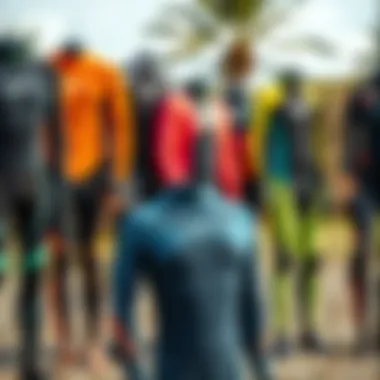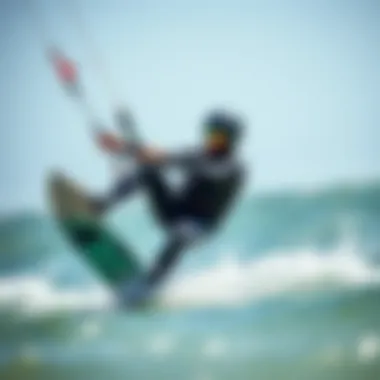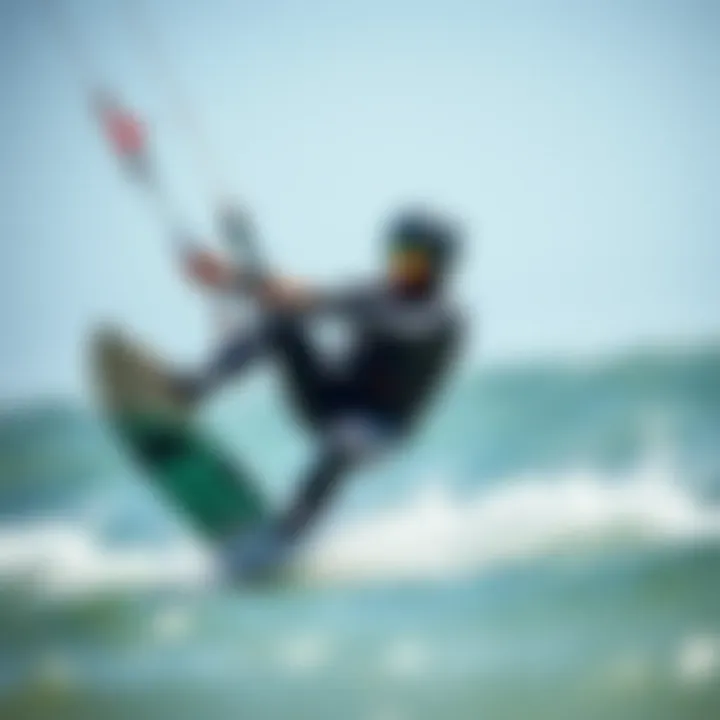Essential Summer Wetsuits for Kiteboarding Enthusiasts


Intro
As the temperatures rise and the wind begins to rip through the coastal air, kiteboarding aficionados everywhere gear up for a thrilling summer season. One of the most crucial pieces of equipment for any kiteboarder is the wetsuit. But, selecting the right wetsuit can feel like finding a needle in a haystack. With endless options out there, understanding the nuances can make the difference between a comfortable ride and a cold, soggy mess. This guide is aimed at simplifying that decision-making process by diving into a comprehensive look at summer wetsuits designed specifically for kiteboarding enthusiasts.
In this exploration, we will dissect the various types of wetsuits, from shorties to full suits, highlight materials and technologies that enhance performance, discuss the importance of fit and functionality, and provide valuable insights on care as well as sustainability. Whether you’re a novice eager to catch your first wave or a seasoned kiteboarding expert looking to refine your gear, we will cover essential tips to ensure your experience on the water is nothing short of spectacular.
Equipped with well-rounded knowledge, you’ll be ready to choose the right wetsuit that complements your style while taking into account the specific water conditions you’ll face. Let’s get started.
Understanding Summer Wetsuits
When it comes to kiteboarding, summer wetsuits play a crucial role, serving as a vital piece of equipment for riders who plan to take on the warm waters and brisk breezes typical of summertime. Understanding what makes these wetsuits unique can significantly enhance your experience on the water, keeping comfort and performance in mind.
What is a Summer Wetsuit?
A summer wetsuit is a specialized piece of gear designed to protect surfers or kiteboarders from both cold water and harmful UV rays while offering flexibility and ease of movement. Unlike their thicker counterparts meant for colder conditions, summer wetsuits are usually made from thinner neoprene, generally ranging from 2mm to 3mm in thickness. The flexibility of these wetsuits allows for an unencumbered range of motion, a must-have for the dynamic movements involved in kiteboarding.
These suits typically come in various cuts, including shorty, long-sleeve, and spring suits, allowing athletes to choose according to their preference or the specific conditions they face. On hotter days, a shorty or spring suit might be ideal, while a long-sleeve variant provides extra protection from the sun and possible scrapes caused by the board.
Differences Between Wetsuits and Drysuits
To truly grasp the essence of a summer wetsuit, it is important to distinguish it from a drysuit. While both serve protective functions, their applications differ vastly. A drysuit, as the name suggests, keeps the wearer completely dry by utilizing a watertight seal and thicker insulation, making it suitable for colder environments where water temperatures can dip below what summer wetsuits can handle. Drysuits are generally bulkier and less flexible, which limits movement when engaging in activities like kiteboarding.
In contrast, a summer wetsuit embraces the water, allowing a thin layer of it to permeate the suit. This water then warms up from the body heat of the wearer, creating a thermal barrier while still enabling an incredibly flexible experience on the water.
"Choosing between a wetsuit and a drysuit boils down to the water conditions and personal preference - understanding their differences can lead to a more enjoyable time on the water."
Types of Summer Wetsuits
When it comes to enjoying kiteboarding during the warmer months, choosing the right wetsuit is key. The types of summer wetsuits available cater to various conditions and personal preferences, making it essential for kiteboarders to understand their options. Each type of wetsuit offers unique benefits, whether you’re looking for mobility, warmth, or simply protection from the elements.
Shorty Wetsuits
Shorty wetsuits, also known as shorty suits, are a popular choice among kiteboarders when the weather is warmer. With short sleeves and cropped legs, they offer a balance of comfort and protection. Here are some advantages:
- Flexibility: Since shorty wetsuits cover less surface area, they allow for much greater freedom of movement. This is crucial for kiteboarding where agility plays a huge role in optimizing performance.
- Cooling Effect: In warmer waters, these suits prevent overheating. The exposed arms and legs help you maintain a comfortable body temperature, so you can focus on your ride rather than feeling stifled.
- Easy to Put On and Take Off: Shorty wetsuits are generally more straightforward to wear, making them a suitable choice for beginners who might struggle with full suits.
Essentially, if you're surfing for pleasure at a sunny beach or catching the wind on a breezy afternoon, a shorty wetsuit could be just the ticket.
Long-Sleeve Wetsuits
Long-sleeve wetsuits offer a bit more coverage, which can be beneficial in slightly cooler temperatures or in areas where sun protection is paramount. Here’s what makes them a viable option:
- Better UV Protection: Long sleeves help shield your skin from harsh sun rays while you're riding the waves.
- Versatility: These suits can be worn in various water temperatures. In slightly cooler evenings, long-sleeve wetsuits provide a tad bit more insulation without being overly restrictive.
- Enhanced Core Warmth: By covering the torso and arms, these suits help maintain core body temperature, allowing you to extend your riding sessions even when conditions aren't perfect.
If you anticipate riding in variable temperatures, a long-sleeve wetsuit can provide that adaptability.
Spring Suits
Spring suits are an interesting crossover between shorties and full wetsuits. With longer arms and short legs, they cater well to both warmth and flexibility. Consider these points when thinking about a spring suit:
- Optimal for Changing Conditions: As the weather shift from warm to chilly, spring suits are ideal for transitional seasons or days when the sun peeks in and out.
- Warmth Without Overheating: Like shorty suits, they prevent overheating but still keep your body heat retained, especially in chilly waters, making them a sweet spot for spring and autumn kiteboarding.
- Ideal for Beginners: The spring suit is a nice middle ground for new kiteboarders who may not be as accustomed to water sports and want a bit more comfort while learning.
In summary, understanding these types of summer wetsuits not only helps you select the right fit but also enhances your overall kiteboarding experience. Selecting wisely means you enjoy your time on the water with comfort and functionality.
Material Composition
When it comes to summer wetsuits for kiteboarding, material composition is a game changer. It significantly impacts not just the comfort but the performance as well. Getting the right material means ensuring the wetsuit is lightweight, flexible, and provides adequate warmth without being a hindrance. Different materials also have various insulation properties, which are crucial when dealing with fluctuating water temperatures on a kiteboarding adventure. Let's delve deeper into the materials commonly used in these wetsuits.
Neoprene Varieties
Neoprene is the gold standard when discussing wetsuits. This synthetic rubber material has gained popularity for several reasons. One major advantage is its thermal insulation capabilities, which is essential for maintaining your body heat in cooler waters. Neoprene also offers excellent stretch, allowing for a greater range of motion while maneuvering on the water.


However, not all neoprene is created equal. There are various types:
- Standard Neoprene: This is the most common type, providing a decent balance between warmth and flexibility.
- Limestone Neoprene: An eco-friendlier alternative, it’s derived from limestone instead of petroleum. While it offers similar benefits to standard neoprene, some users argue it provides even more flexibility.
- Super Stretch Neoprene: If you’re after maximum flexibility, this type shines. While it may sacrifice some insulation, it allows for unparalleled mobility, often favored by more skilled kiteboarders.
The choice here depends on the rider’s needs, water conditions, and personal preferences. For someone who prioritizes warmth and rugged performance, standard neoprene may suffice. But for athletes pushing the limits, opting for super stretch could be the ticket.
Alternative Materials
As the emphasis on sustainability grows, alternative materials are gaining traction in the wetsuit industry. These alternatives often consider both performance and environmental impact, making them attractive for environmentally-conscious kiteboarders.
- Yulex: Made from natural rubber, it’s a sustainable alternative to traditional neoprene. It provides enough insulation while being less harmful to the planet. Some users have praised it for its softness and comfort.
- Recycled Polyester: Utilizing plastics that have been previously used, this material is another step toward sustainability. While it doesn’t provide the same insulation as neoprene, its lightweight nature can be ideal for warmer water conditions.
- Ecolast: A blend that incorporates both recycled materials and natural elements, Ecolast not only enhances environmental considerations but also maintains decent performance levels, marrying sustainability with functionality.
Choosing alternative materials is as much about caring for the environment as it is about performance. Kiteboarders can feel good knowing that with the right choice, they’re protecting our oceans while enjoying their sport.
"The right material in your wetsuit is more than just a comfort choice—it's a performance enhancer that keeps the kiteboarding experience at its best."
For more insights on material usage in water sports, you can visit Wikipedia or consult further materials at educational resources like Britannica.
Key Features to Consider
When engaging in the exhilarating activity of kiteboarding, the right wetsuit plays a pivotal role in ensuring comfort and performance. It's a bit like picking the right tool for a job; each feature of a wetsuit has its purpose, and understanding these can elevate your kitesurfing experience. Here are several key characteristics to scrutinize when selecting a summer wetsuit.
Thickness and Insulation
The thickness of a wetsuit can significantly affect your thermal comfort on the water. Most summer wetsuits range from 1mm to 3mm in thickness. A thinner suit, around 1.5mm to 2mm, is usually hot enough for summer conditions while still allowing for flexibility and ease of movement. You don't want a suit that feels like a straightjacket while you’re out riding waves.
Insulation is connected to thickness, yet it also depends on the wetsuit's interior lining and material composition. A high-quality inner lining can trap body heat without sparking a sauna effect. Do you prefer to feel a little cool and agile, or are you more inclined to enjoy the extra warmth? Each surfer's preferences differ, and understanding your own tolerance towards temperatures is essential.
"Choosing a wetsuit isn't just about keeping warm; it’s about maintaining an edge in your performance while out on the water."
Seam Construction
The construction of seams isn’t just a trivial detail; it holds the key to both durability and comfort. Typically, wetsuits come with several types of seams: flatlock, blind stitched, and taped seams. The flatlock seams are commonly found in entry-level suits, excellent for warm conditions but not ideal for water pressure.
Blind-stitched seams add a level of protection; they don’t pierce through the neoprene as traditional stitches do, making them more waterproof. For ultimate durability and water resistance, look for taped seams, which use an adhesive tape on the inside of the seam. This approach can effectively minimize water entry, keeping you drier longer during your kiteboarding sessions.
Zipper Types
Zippers are often overlooked but play a fundamental role in ease of entry and exit as well as overall fit. There are primarily three zipper types you might encounter: rear, chest, and no-zipper designs.
- Rear Zipper: This is the most common type. It provides simple access, but getting that darn thing zipped up can occasionally come off as a two-man job.
- Chest Zipper: Offers a tighter seal, which can be a boon for warmth, but may complicate quick changes.
- No-Zipper: These suits rely on the stretch of the neoprene itself to create an incredibly snug fit, minimizing water entry altogether.
Regardless of your choice, ensure the zipper functions smoothly. Some zippers can be finicky, especially when you’re battling with the wind and waves.
In sum, the right combination of thickness, seam construction, and zipper type can greatly influence your comfort and performance on the water. Getting thoughtfully acquainted with these details will not just enhance your time spent kiteboarding but will also make sure you're well-equipped to tackle whatever the sea throws your way.
Fit and Sizing Considerations
When it comes to kiteboarding, the gear you choose can drastically influence your performance, comfort, and overall experience on the water. One critical aspect of this gear is the wetsuit. The fit and sizing of a wetsuit cannot be overstated; they play a monumental role in how well you can move and react in the water. A proper fit ensures that your wetsuit hugs your body snugly without being restrictive, allowing for optimal flexibility and thermal regulation. This means that being selective about sizing can significantly affect how you maneuver while kiteboarding, and, ultimately, your enjoyment of the sport.
Importance of Proper Fit
A wetsuit that fits correctly is akin to a second skin. It should keep you warm by trapping a thin layer of water between your body and the suit, which warms up thanks to your body heat. However, if the suit is too loose, that precious warmth can escape, causing discomfort and chill, especially during those long sessions on cooler summer days. Conversely, if it's excessively tight, you might feel restricted, making it hard to execute those sharp turns and jumps.
- Enhanced Comfort: A well-fitting wetsuit allows for seamless movements, enabling you to enjoy long hours on the water without the nagging sensations of pinching or constriction.
- Increased Performance: With optimal flexibility, you can respond quickly to changing conditions, adjusting your stance and harnessing the wind more effectively.
- Minimized Water Entry: A snug fit minimizes the chances of water pooling inside, reducing the drag that could slow you down mid-ride.
In essence, the right fit helps kiteboarders both novice and experienced to simulate their natural movements, ensuring they can focus on enjoying the ride rather than fussing over their gear.
Measuring for Correct Size
To find the perfect wetsuit, you’ll need to take a few measurements. While brands might have slightly different sizing charts, following a straightforward method will get you close to what you need. Here’s a handy step-by-step guide to measuring for the right size:


- Chest Measurement: Measure around the widest part of your chest, keeping the tape measure snug but not constricting your breathing.
- Waist Measurement: Measure around the narrowest part of your waist.
- Hip Measurement: Measure around your largest hip area, which is essential for those suits designed to allow full range of motion.
- Height Measurement: Stand straight and measure from the top of your head to the floor.
- Weight Consideration: Lastly, keep your weight in mind, as it plays a role in fit and buoyancy.
After you’ve taken your measurements, compare them on the sizing chart provided by the wetsuit brand. Most manufacturers provide guidance on how to interpret these numbers, allowing you to select the size that will provide the best fit for impactful kiteboarding sessions.
If you find yourself on the border of two sizes, consider your riding style and the conditions you typically face. For example, if you often venture out in varying temperatures or ride aggressively, opting for a tighter fit might be advantageous.
Ultimately, investing time into accurately measuring and understanding your fit will pay dividends when you're out on the water. Your wetsuit can be a source of enjoyment rather than an obstacle if it fits like a glove.
Performance and Functionality
When it comes to kiteboarding, the suitability of your wetsuit can make or break your experience on the water. Performance and functionality are crucial considerations that go beyond mere aesthetics or fit. To truly enjoy those breezy summer days on your board, it's essential to understand these key elements that determine how effectively your wetsuit can assist you in the water while also ensuring comfort and safety.
Flexibility in Movement
A kiteboarder’s ability to maneuver skillfully often hinges on the flexibility offered by their wetsuit. No one wants to feel restricted when chasing the wind and waves. The design and cut of a wetsuit should allow for a full range of motion, letting you twist, bend, and stretch without feeling like you're encased in a tin can.
Wetsuits typically feature specific designs like:
- Anatomical panels that cater to movement, reducing resistance during kiting action.
- Glued and blind-stitched seams that not only minimize water entry but also ensure that seams remain flexible without a bulk of excess material, allowing for agile movements.
Moreover, high-quality neoprene materials work wonders at enhancing this flexibility. The latest advancements in neoprene, such as super-stretch and lightweight options, empower kiteboarders to perform better—whether they're executing jumps or carving turns. A well-fitting wetsuit should feel like a second skin, aiding your performance instead of hindering it.
Thermal Regulation Features
Equally as important as flexibility is the ability to manage temperature fluctuations. Kiteboarding isn't just about riding the wind; it’s essential to stay comfortable and prevent hypothermia when the sun dips below the horizon. A quality wetsuit is outfitted with thermal regulation features that focus on maintaining body heat without overheating the wearer.
Key features include:
- Water-resistant linings that reflect body heat. Materials such as Thermo Lite or Smart Foam not only keep you warm but are also lightweight.
- Strategically placed panels made with different thicknesses, allowing for optimal insulation in critical areas while still offering flexibility in the limbs.
Ultimately, the importance of thermal regulation cannot be overstated. If a wetsuit keeps you warm without making you feel like you're boiling in a pot, it empowers you to focus entirely on your kiteboarding skills.
"Investing in the right wetsuit can literally change your game, enhancing both comfort and performance, allowing for uninterrupted sessions on the water."
By understanding how these performance and functionality features work together, kiteboarders are better equipped to make informed decisions when selecting the right wetsuit. The end goal is to enhance the experience, making each ride as thrilling as it should be.
Maintenance and Care
Taking care of your summer wetsuit is essential for prolonging its life and ensuring optimal performance in the water. This part of the guide emphasizes the importance of proper maintenance practices that can save kiteboarders from unexpected gear malfunctions during their adventures.
A well-maintained wetsuit not only extends the fabric's lifespan but also ensures that it retains its thermal insulation properties. The sea, with all its salt and sand, can be quite harsh on your gear. Regular cleaning and proper storage are paramount to combat the wear and tear that comes from frequent use. Neglect can lead to material breakdown, loss of flexibility, and funky odors that can ruin what should be a thrilling kitesurfing experience.
Cleaning Techniques
Keeping your wetsuit clean is not just about looking good on the beach; it significantly affects its performance. After a vigorous day of kiteboarding, your wetsuit encounters saltwater, sand, and sunscreen residues, all of which can interact negatively with the neoprene material when left unchecked. Here are some effective cleaning techniques to consider:
- Rinse Immediately: Always rinse your wetsuit in fresh water right after you get out of the water. This helps to wash away salt and sand that can wear down the material.
- Use Mild Soap: If your suit is particularly dirty, a mild cleanser specifically designed for wetsuits can do wonders. Avoid harsh detergents that can compromise the suit's integrity.
- Hand Wash: Gently wash your wetsuit by hand. Avoid using a washing machine, as the agitation can damage the seams.
- Avoid Hot Water: Steer clear from hot water, as it can degrade the neoprene and affect its elasticity.
- Air Dry: Lay your wetsuit flat or hang it in the shade to dry. Direct sunlight can cause it to fade and lose its durability over time.
"Regular care not only keeps your wetsuit in top shape but also enhances your comfort while kiteboarding. A clean wetsuit is a happy wetsuit!"
Storage Best Practices
Where and how you store your wetsuit can be just as important as how you clean it. Proper storage helps to maintain its shape and functional qualities. When you hang up your gear, consider these practices:
- Hang It Up Right: Use a wide hanger to prevent the shoulders from stretching. This way, you can maintain the shape of the suit and avoid unsightly laps that could lead to wear.
- Cool, Dry Place: Store the wetsuit in a cool, dry environment. Excessive heat and humidity can weaken the fabric.
- Avoid Folding: Try not to fold the wetsuit, as creases can form and over time compromise the fit and flexibility.
- Prevent Dunlight Exposure: Keep it away from direct sunlight to prevent damage to the colors and material. A cloth bag or even a wetsuit-specific storage bag can work well here.
- Periodic Checks: Once in a while, take a peek at your wetsuit to catch any signs of damage or wear early on. This ensures you're always ready to hit the water when the winds are just right.
By following these maintenance and care tips, kiteboarders can ensure that their summer wetsuits last longer and perform better, making those summer sessions all the more enjoyable.
Sustainability in Wetsuit Production
In today’s world, where environmental concerns are taking center stage, the production of summer wetsuits for kiteboarding is no exception. Sustainability in wetsuit production has become a vital topic for both manufacturers and consumers alike. Kiteboarders are becoming increasingly aware that their choices can impact the planet. Thus, understanding the importance of sustainability in this niche market can help you make more informed decisions. It’s not just about hitting the waves; it’s about ensuring that those waves remain clean and the marine ecosystems thrive.


Sustainable practices in wetsuit production can contribute positively in several ways:
- Reduction of Carbon Footprint: Using eco-friendly materials helps minimize the overall environmental impact.
- Conservation of Resources: Sustainable practices often involve using fewer resources such as water and energy during the manufacturing process, leading to less waste.
- Awareness and Education: Supporting brands that focus on sustainability raises awareness in the community, promoting more environmentally conscious choices.
"The future of kiteboarding gear hinges on our commitment to sustainable practices, enabling us to enjoy the sport without compromising the health of our planet."
Eco-friendly Materials
When it comes to eco-friendly materials, innovation is at the forefront. Traditional neoprene, while effective, is derived from petroleum, which isn’t the best for the environment. Thankfully, several brands now incorporate eco-conscious alternatives. For instance, some manufacturers utilize limestone-based neoprene, which offers similar performance to traditional neoprene but carries a significantly reduced carbon footprint. Yulex, derived from natural rubber, is another promising option. This material not only affords flexibility and comfort but also ensures that the production process is less harmful to the environment.
Moreover, recycled materials are being pioneered as essential components in wetsuit construction. This involves using materials pulled from old wetsuits or other plastic sources, giving them a second life and reducing waste in landfills. By investing in wetsuits made from such sustainable materials, kiteboarders can enjoy their sport while minimizing their environmental footprint.
Recycling Programs
In line with the shift toward sustainability, many companies are stepping up with recycling programs aimed at minimizing waste. These initiatives allow consumers to return their old wetsuits to the manufacturer, where they can be broken down and repurposed. Not only does this practice prevent discarded wetsuits from ending up in landfills, but it also creates a circular economy within the wetsuit industry. Some brands actively encourage customers to send in their old suits, sometimes even offering discounts on new purchases as a reward.
The implementation of these programs instructs consumers on responsible disposal methods and inspires a communal effort towards sustainability. As the demand for kiteboarding gear rises, so does the need to shift towards environmentally sound practices. Conveyor belts of discarded suits can become a thing of the past if these initiatives gain traction among manufacturers and consumers alike.
For further insights, consider visiting resources such as Wikipedia, Britannica, or participation in forums like Reddit where fellow enthusiasts discuss sustainable practices.
Choosing the Right Wetsuit
Selecting the right wetsuit is not merely about aesthetics; it can significantly impact your kiteboarding experience. A suitable wetsuit provides not only warmth but also the necessary flexibility and comfort while riding the waves. Summer water conditions tend to fluctuate; hence, understanding your needs before making a purchase is essential. Here are some specific elements that should guide your decision-making process:
- Water Temperature: Different regions boast varying water temperatures in summer, affecting your choice of wetsuit type and thickness. Cooler waters might necessitate a thicker wetsuit, while warmer areas can allow for more flexibility with lighter options.
- Activity Level: Consider how active you are while kiteboarding. If you tend to spend long hours in the water, a suit that prioritizes comfort and breathability can be invaluable.
- Style Preferences: Your style of kiteboarding may also dictate what kind of wetsuit is best suited for you. Some folks favor high-mobility designs, while others may prefer more traditional styles.
While the price tag can be tempting to overlook in favor of looks or features, investing in a quality wetsuit from the start can save you a headache down the line. No one enjoys wrestling with a suit that’s ill-fitting or poorly designed on a windy summer day.)
Assessing Water Conditions
Water conditions can vary wildly depending on your chosen kiteboarding location, and understanding these factors is crucial to selecting the right wetsuit. Here’s what to keep in mind:
- Water Temperature: The most obvious factor. Assessing the temperature of the water will help you decide on the thickness of your wetsuit. Colder waters may necessitate a heavier suit, whereas warmer waters will likely require a lighter option. Many kiteboarders often make the mistake of underestimating how cool the water can be even on warm days.
- Current and Wave Activity: This could affect your body temperature while you’re in the water. Strong currents and waves can mean a need for more coverage or insulation. Keeping yourself warm in these conditions is paramount, otherwise you'll be fighting against the elements as well as your ride.
- Weather Conditions: Wind and sun are not to be ignored. Hot sun can lead to overheating, and strong winds can make the water feel colder than it is. A suit with great breathability becomes essential when the sun’s glaring down.
Maintaining awareness of these water conditions is key to ensuring your enjoyment and safety while kiteboarding. It’s always wise to check local weather forecasts and water temperature reports before heading out.
Personal Preference Factors
Choosing a wetsuit is just as much about personal preferences as it is about water conditions. Here are some factors that might resonate with you:
- Fit Style: Some kiteboarders swear by the snug fit of a full wetsuit, while others prefer the flexibility of a shorty. Consider what has felt comfortable for you in the past.
- Movement Range: If you’re someone who enjoys intricate maneuvers, you might need a wetsuit designed for high flexibility. The right cut will enhance your agility on the board.
- Design and Aesthetics: Let’s face it, a suit that looks good can do wonders for your confidence. Choose colors or styles you enjoy that also complement your kiteboarding gear.
These personal preferences should guide your selection process to ensure you feel confident and comfortable during every outing.
"Ultimately, the best wetsuit for kiteboarding blends personal comfort with the demands of the water. Never underestimate the value of a good fit and the right materials."
In summary, choosing a wetsuit requires balancing various factors to enhance both performance and enjoyment on the water. By assessing water conditions and personal preferences carefully, kiteboarders can make informed decisions that ultimately lead to a more satisfying on-the-water experience. Consider visiting resources like Wikipedia or Britannica for more in-depth information.
Ending
The significance of concluding an article on summer wetsuits for kiteboarding lies in providing readers with the final lens through which they can assess everything previously discussed. It’s not just about wrapping things up but ensuring that kiteboarders understand the essence of the information laid out, enabling informed decisions for their summer adventures.
Summary of Key Insights
During this comprehensive exploration, we unwrapped several essential aspects that every kiteboarder should consider:
- Types of Wetsuits: Knowing the differences between shorty wetsuits, long-sleeve wetsuits, and spring suits can greatly influence comfort and performance. Each type has its specific use case, suited for varying water temperatures and conditions.
- Material Composition: The variety of neoprene used, alongside alternatives like limestone-based materials, can impact warmth and stretch. It's crucial to choose a wetsuit that balances these two elements to enhance mobility while ensuring thermal protection.
- Key Features: From thickness to zipper types, these elements matter. A well-constructed wetsuit with appropriate seam technology and features can make a difference in comfort and durability.
- Fit and Sizing: A proper fit is not just about style; it's vital for performance. The right measurements can mean the difference between freedom of movement and feeling restricted.
- Maintenance: Knowing how to care for your wetsuit prolongs its life. Techniques for cleaning and storage can prevent wear and tear, keeping your gear in prime condition.
- Sustainability: With growing awareness of environmental issues, considering eco-friendly materials and recycling options can help the industry progress towards more sustainable practices.
- Choosing the Right Wetsuit: Water conditions play a significant role in the choice of wetsuit. Assessing both the environment and personal preferences ensures that every kiteboarding session is enjoyable and safe.
"Choosing the right wetsuit is as crucial as picking the perfect kite. The two go hand in hand in ensuring an enjoyable experience on the water."
Final Recommendations
As we draw the curtain on this guide, here are some parting recommendations:
- Invest in quality: Don’t squeeze pennies when it comes to wetsuits. The right investment in a quality wetsuit can significantly enhance your performance.
- Try before you buy: If possible, take a few different options for a spin. A wetsuit that fits one person like a glove may feel like a straitjacket on another.
- Stay updated: As technology advances, so do wetsuit designs. Keep an eye on the latest trends and innovations to ensure you are not missing out on enhancements that could enhance your experience.
- Connect with the community: Engage with other kiteboarders to gather personal opinions and recommendations. Platforms like Reddit or kiteboarding forums can provide invaluable insights.
- Consider future conditions: Think about water conditions not just for today, but what you’ll face in the coming months. Select a wetsuit that has versatility for changing temperatures.
In essence, this guide aims to arm both novice and seasoned kiteboarders with the vital knowledge necessary for selecting the perfect summer wetsuit, ensuring an overall enjoyable and successful kiteboarding experience. With these insights in hand, readers are well-equipped to navigate the waters this summer.







